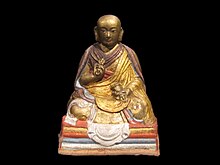Soyombo script
| Soyombo script | ||
|---|---|---|
| Font | Abugida | |
| languages | Mongolian , Tibetan , Sanskrit | |
| inventor | Dsanabadsar | |
| Emergence | 1686 | |
| Usage time | 17th and 18th centuries | |
| Used in | Mongolia | |
| ancestry |
Devanagari → Ranjana script → Sojombo script |
|
| Unicode block | U + 11A50 - U + 11AAF | |
The soyombo alphabet ( Mongolian Соёмбо бичг , sojombo bitschg ) is a syllabary ( Abugida ), which in 1686 by the Mongolian monk and scholar Zanabazar , is designed to Mongolian writing. But it can also be used for Tibetan and Sanskrit .
A special sign of the writing, the Sojombo symbol , has become a national symbol of Mongolia , which has been included in the state flag since 1921 and in the state coat of arms since 1992 .
Emergence
The Sojombo script was the fourth Mongolian writing system, and probably originated in 1686, d. H. only 40 years after the invention of clear script .
According to a legend, Dsanabadsar is said to have seen letter-like signs in the sky one night, from which he developed his new script. The name of the font refers to this story. It is a modification of the Sanskrit word Svayambhu , which means "originated from itself".
In reality, the syllable system is based on the alphabet of the Devanagari script and the basic form of the characters is based on the Indian Lantsa script (Ranjana). Details of the individual characters are reminiscent of the Mongolian script and the Orkhon runes . It is unclear whether Dsanabadsar designed the Soyombo symbol himself or whether it existed before.
use
Dsanabadsar had created the script for the translation of Buddhist texts from Sanskrit or Tibetan, and used it extensively with his students. This task was due to the complexity of the script, which makes it possible to reproduce other scripts and languages exactly. However, it was too complicated to write to establish itself as everyday script. In addition, the accuracy of the Sojombo script meant that the Mongolian dialects were spelled differently with it, which led to communication problems. Here the classic Mongolian script had an advantage.
The Sojombo script was primarily used for ceremonial purposes as a splendid script by the Eastern Mongols. Today the script is no longer actively used. You can find them (besides historical texts) mainly in temple inscriptions and on prayer wheels. It is also important for linguistics, as some developments in the Mongolian language can be read from it, such as: B. the origin of long vowels.
shape
The Sojombo script was the first Mongolian script to be written horizontally from left to right, in contrast to the vertical notation of earlier scripts. As with the Tibetan and many Indian scripts, the characters hang under a horizontal element that visually holds the line together.
The two variants of the Sojombo symbol serve as special characters to mark the beginning and end of a text. Two of its elements (the upper triangle and the right vertical bar) serve as an angular framework for the other characters.
The syllables are made up of one to three elements within this framework. The first consonant is shown at the top within the angle. The vowel is expressed by a marker above the character, with the exception of u and ü, which are marked in the lower center. A second consonant is attached to the bar in a smaller form below within the angle, and possibly pushes the marking for u or ü a little to the left. To mark long vowels, a short diagonal line is added at the bottom of the vertical bar. For the two diphthongs there is a curved resp. Jagged marking to the right of the vertical bar.
alphabet
The first character of the alphabet represents a single short a. For the other single vowels, the same character is used together with a vowel marker. All other main signs are consonants. If a consonant does not contain a vowel mark, then the syllable is implicitly completed with an a.
With 20 consonants and 14 vowels, almost 4000 combinations are theoretically possible, but not all of them are used. For writing in Tibetan or Sanskrit, there are additional characters and markings.
As a punctuation mark there is a point next to the Soyombo symbol , which is shown as a vertical bar. With inscriptions you often see a superscript point (at the height of the upper triangle) as a word separator.
Unicode
The Sojombo font is only included in version 10.0 of the Unicode standard. The area U + 11A50-11AAF of level 1 is defined there.
See also
Web links
- Sojombo Fonts (TeX / Metafont)
- Sojombo Fonts ( Memento from December 9, 2007 in the Internet Archive ) (TTF)


